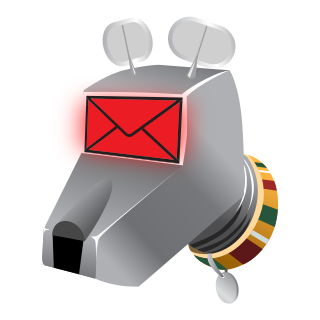Related Research Articles

ASCII, abbreviated from American Standard Code for Information Interchange, is a character encoding standard for electronic communication. ASCII codes represent text in computers, telecommunications equipment, and other devices. Because of technical limitations of computer systems at the time it was invented, ASCII has just 128 code points, of which only 95 are printable characters, which severely limited its scope. All modern computer systems instead use Unicode, which has millions of code points, but the first 128 of these are the same as the ASCII set.

Electronic mail is a method of exchanging messages ("mail") between people using electronic devices. Email was thus conceived as the electronic (digital) version of, or counterpart to, mail, at a time when "mail" meant only physical mail. Email has become such a ubiquitous communication medium to the point that in current use, an email address is often treated as a basic and necessary part of many processes in business, commerce, government, education, entertainment, and other spheres of daily life in most countries.
Multipurpose Internet Mail Extensions (MIME) is an Internet standard that extends the format of email messages to support text in character sets other than ASCII, as well as attachments of audio, video, images, and application programs. Message bodies may consist of multiple parts, and header information may be specified in non-ASCII character sets. Email messages with MIME formatting are typically transmitted with standard protocols, such as the Simple Mail Transfer Protocol (SMTP), the Post Office Protocol (POP), and the Internet Message Access Protocol (IMAP).
The Simple Mail Transfer Protocol (SMTP) is an Internet standard communication protocol for electronic mail transmission. Mail servers and other message transfer agents use SMTP to send and receive mail messages. User-level email clients typically use SMTP only for sending messages to a mail server for relaying, and typically submit outgoing email to the mail server on port 587 or 465 per RFC 8314. For retrieving messages, IMAP is standard, but proprietary servers also often implement proprietary protocols, e.g., Exchange ActiveSync.
A signature block is a personalized block of text automatically appended at the bottom of an email message, Usenet article, or forum post.
8-bit clean is an attribute of computer systems, communication channels, and other devices and software, that handle 8-bit character encodings correctly. Such encoding include the ISO 8859 series and the UTF-8 encoding of Unicode.

Microsoft Outlook is a personal information manager software system from Microsoft, available as a part of the Microsoft Office and Microsoft 365 software suites. Though primarily an email client, Outlook also includes such functions as calendaring, task managing, contact managing, note-taking, journal logging and web browsing, and has also become a popular email client for many businesses.
Outlook Express, formerly known as Microsoft Internet Mail and News, is a discontinued email and news client included with Internet Explorer versions 3.0 through to 6.0. As such, it was bundled with several versions of Microsoft Windows, from Windows 98 to Windows Server 2003, and was available for Windows 3.x, Windows NT 3.51, Windows 95, Mac System 7, Mac OS 8, and Mac OS 9. In Windows Vista, Outlook Express was superseded by Windows Mail.

Mozilla Thunderbird is a free and open-source cross-platform email client, personal information manager, news client, RSS and chat client that is operated by the Mozilla Foundation's subsidiary MZLA Technologies Corporation. Thunderbird is an independent, community-driven project that is managed and overseen by the Thunderbird Council, which is elected by the Thunderbird Community. The project strategy was originally modeled after that of Mozilla's Firefox web browser and is an interface built on top of that web browser.

Apple Mail is an email client included by Apple Inc. with its operating systems macOS, iOS, iPadOS and watchOS. Apple Mail grew out of NeXTMail, which was originally developed by NeXT as part of its NeXTSTEP operating system, after Apple's acquisition of NeXT in 1997.
An email address identifies an email box to which messages are delivered. While early messaging systems used a variety of formats for addressing, today, email addresses follow a set of specific rules originally standardized by the Internet Engineering Task Force (IETF) in the 1980s, and updated by RFC 5322 and 6854. The term email address in this article refers to just the addr-spec in Section 3.4 of RFC 5322. The RFC defines address more broadly as either a mailbox or group. A mailbox value can be either a name-addr, which contains a display-name and addr-spec, or the more common addr-spec alone.
uuencoding is a form of binary-to-text encoding that originated in the Unix programs uuencode and uudecode written by Mary Ann Horton at UC Berkeley in 1980, for encoding binary data for transmission in email systems.
When a message is replied to in e-mail, Internet forums, or Usenet, the original can often be included, or "quoted", in a variety of different posting styles.
Kontact is a personal information manager and groupware software suite developed by KDE. It supports calendars, contacts, notes, to-do lists, news, and email. It offers a number of inter-changeable graphical UIs all built on top of a common core.
Many email clients now offer some support for Unicode. Some clients will automatically choose between a legacy encoding and Unicode depending on the mail's content, either automatically or when the user requests it.
HTML email is the use of a subset of HTML to provide formatting and semantic markup capabilities in email that are not available with plain text: Text can be linked without displaying a URL, or breaking long URLs into multiple pieces. Text is wrapped to fit the width of the viewing window, rather than uniformly breaking each line at 78 characters. It allows in-line inclusion of images, tables, as well as diagrams or mathematical formulae as images, which are otherwise difficult to convey.
End of message or EOM signifies the end of a message, often an e-mail message.
International email arises from the combined provision of internationalized domain names (IDN) and email address internationalization (EAI). The result is email that contains international characters, encoded as UTF-8, in the email header and in supporting mail transfer protocols. The most significant aspect of this is the allowance of email addresses in most of the world's writing systems, at both interface and transport levels.
Setext is a lightweight markup language used to format plain text documents such as e-newsletters, Usenet postings, and e-mails. In contrast to some other markup languages, the markup is easily readable without any parsing or special software.

K-9 Mail is free and open source email client for Android. It is designed as an alternative to the stock email clients included with the platform; it supports both POP3 and IMAP protocols and supports IMAP IDLE for real-time notifications. The project is named after the Doctor Who character K9.
References
- ↑ Sperling, Patric (2002-12-23) [2000], ASCII Ribbon Campaign — against HTML mail, vCards and proprietary formats, DE: Pasp, retrieved 2013-02-04.